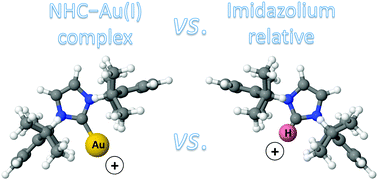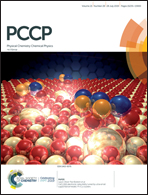Quantifying electronic similarities between NHC–gold(i) complexes and their isolobal imidazolium precursors†
Abstract
A series of NHC–gold(I) (NHC = N-heterocyclic carbene) complexes has been studied by DFT calculations, enabling comparison of electronic and NMR behaviour with related protonated and free NHC molecules. Based on calculations, the NMR resonances of the carbenic C2 carbon atom in [Au(NHC)(Cl)] and [NHC(H)][Cl] exhibit increased shielding when compared to the free N-heterocyclic carbenes by an average of 46.6 ± 2.2 and 73.7 ± 4.3 ppm, respectively. A similar trend is observed when analysing the paramagnetic term of the magnetic shielding tensor. Although gold(I) and proton are considered isolobal fragments, imidazolium compounds lack π-backdonation due to the energetic unavailability of d-orbitals in H+. We propose that NHC–gold(I) complexes exhibit important π-backdonation irrespective of the relative amount of σ-donation between the NHC and gold(I)–X (X = anionic ligand) moieties in Au–NHC complexes. Interestingly, a correlation exists between the calculated shielding for gold (197Au) and the π-donation and π-backdonation contributions. We describe that this correlation also exists when analysing the σ-backdonation term, a property generally ignored yet representing a significant energetic contribution to the stability of the C2–Au bond.



 Please wait while we load your content...
Please wait while we load your content...